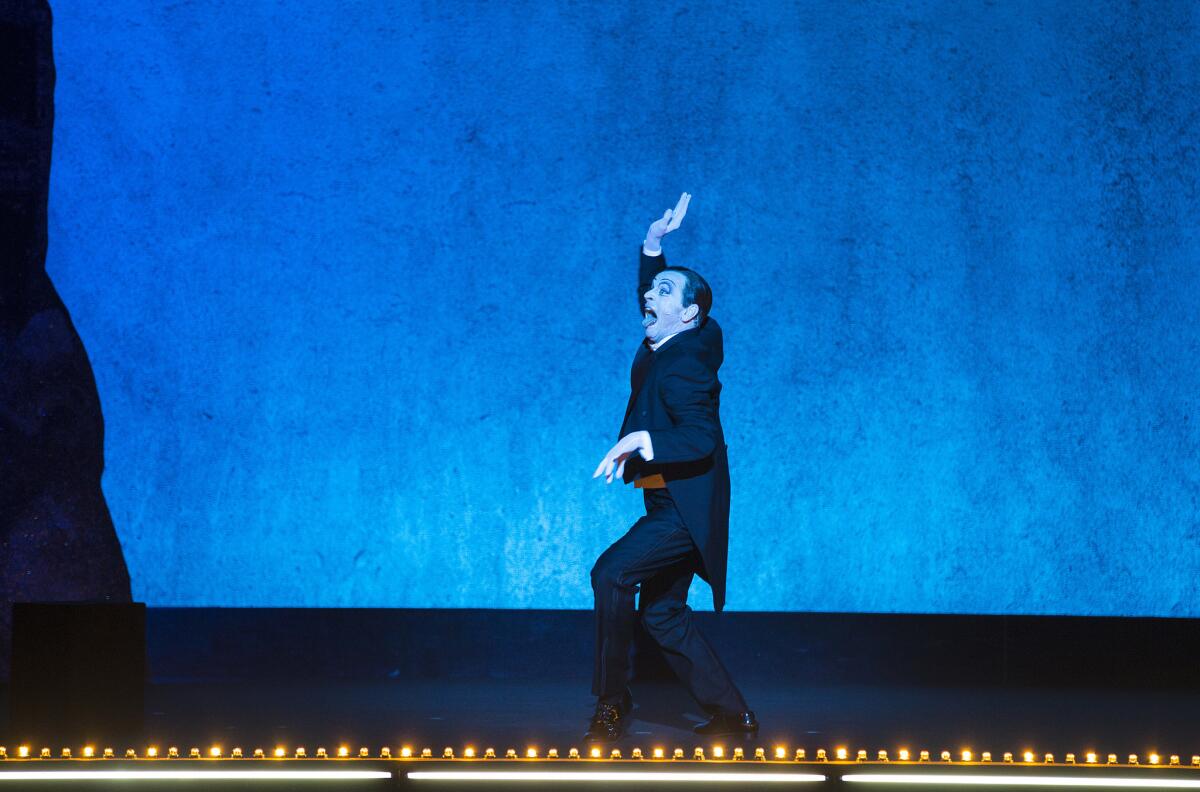Review: Baryshnikov captures Nijinsky’s madness in near-perfect ‘Letter to a Man’

- Share via
Vaslav Nijinsky is reputed to have been the most stupendous dancer after Terpsichore, the Greek goddess of dance. We have no moving pictures of this real-life Russian god’s performances, just suggestive photographs and the accounts of the scandalous eroticism he brought to Debussy’s “Afternoon of a Faun” and his scandalous sensationalism that helped incite the riot at the premiere of “Rite of Spring.”
But it is the fascination with his madness that has also made Nijinsky the subject of books, movies, plays, novels and poems, along with the inevitable psychology studies. Seven years after the 1913 “Rite” riot in Paris, Nijinsky had already begun his own radical rite of disorientation. In what may be the most vivid document ever of a mind coming untethered, step by shocking step, Nijinsky captured in a daily dairy for several weeks his thoughts in their fleeting seconds. He then spent the next three decades institutionalized before his death in 1950.
Is this every great dancer’s fear, that committing a life to dance, to a nearly inhuman yet utterly human merging of mind and body, can overwhelm the senses?
The most celebrated dancer of our time, a Russian who grew up in Nijinsky’s shadow as another Mariinsky Ballet prodigy in St. Petersburg, Mikhail Baryshnikov, has inevitably been asked time and again to portray Nijinsky on film or stage, and he always had resisted.
Now he has relented. On Friday he appeared at UCLA’s Royce Hall for the first of two Center for the Art of Performance dates in Robert Wilson’s “Letter to a Man,” a one-man show for Baryshnikov based on Nijinsky’s diaries. We see what all the fuss is about. Baryshnikov enters the soul of a lost soul, a soul close — and, at the same time, distant — to his own.
Although dazzling in its trademark Wilson lighting, this is no show for anyone afraid of the dark. Baryshnikov perilously goes to the other side, giving in to the madness. But unlike Nijinsky, Baryshnikov emerges greater than ever.
As pure theater, “Letter to a Man” comes close to perfection. We’re not watching just anybody go crazy, but a great artist. Every instant, every sight, every movement becomes a compelling, forcefully weird work of art.
For 65 minutes, Wilson provides one exquisite stage picture after another after another. Long the master of illumination and with lighting cues seemingly timed to the millisecond, Wilson can trigger effects that make the stage go from black to brilliant colors or projections and back with the snap of a finger.
The tiniest features of Baryshnikov, be it his lavishly painted lips and eyebrows, even his tongue, are irradiated for meaning, as when framed in a glowing doorway, like a butterfly under glass, motionless, his mouth frozen, agape in a Munch-like scream.
Baryshnikov here is an exaggerated being, suavely dressed and intricately made up so that he can be, depending on movement and expression and lighting and setting, a soigné, a clown, a vampire, a vaudevillian, a surreal character out of Gogol or a paranoid one out of Dostoyevsky. At the drop of a hat, Baryshnikov comes to life with the sly, smooth, beguiling shuffle steps. Stillness and motion are, for him, two sides of the same being, and whether moving or striking a pose, he is ever picture worthy.
Details are exceptional. Hal Willner has put together one of his typically eclectic musical backgrounds in which Bob Dylan, Arvo Pärt, cabaret music and heaven-knows-what arrive and disappear in quick cuts just like the scene changes and movement. Music doesn’t necessarily mirror meaning. The soundscape, with its crystalline amplification and uses of spacial effects, is another art form all its own.
The text, taken from Nijinsky’s diaries and put into a cubistically precise, dramatic structure by Darryl Pinckney, tells you nothing and everything. Nijinsky’s ravings are heard over loudspeakers, repeated again and again, each time with different cool or hysteric emphases by Wilson or by choreographer-actor Lucinda Childs. Baryshnikov repeats the same lines too, in Russian, adding yet other accents.
Many cooks were in the gleamingly spotless kitchen (the list of credits is impressively long), and yet everything feels perfectly arranged, a perfection that is also so fluid you are never allowed to dwell on it. Every few seconds, a loud click is heard and Wilson takes another snapshot of the ever-changing Russian soul.
Still, it is Baryshnikov as physical being who ultimately makes this matter. The meticulous choreography he jointly worked out with Wilson and Childs looks spontaneous, as though Nijinsky’s body could be an appropriately precise mirror of his mind as it reinvents reality with all the paranoia, black humor and deep pathos of the Russian character.
Through it all, we may discover to our horror that madness is ultimately the other guy holding the clicker and impulsively changing the channel. And suddenly it becomes clear. It’s the remote! The madness of our time, the succumbing to distraction, our demands for immediate attention gratification, began with the clicker.
“Letter to a Man” is a warning to mankind. Slow everything down, freeze the madness as art, pay real attention, try to grasp what is too fleeting to grasp yet cannot be escaped, and watch how not only madness but also sanity happen.
ALSO
Bach forever! Camerata Pacifica enters the fray
Lena Hall on her history-making double play in ‘Hedwig and the Angry Inch’
Broadway’s fall revivals: Why big stars can’t make up for a lack of artistic vision
More to Read
The biggest entertainment stories
Get our big stories about Hollywood, film, television, music, arts, culture and more right in your inbox as soon as they publish.
You may occasionally receive promotional content from the Los Angeles Times.











